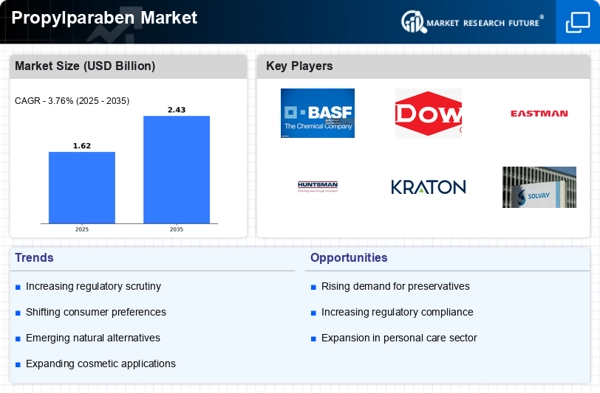Consumer Awareness and Education
Consumer awareness regarding ingredient safety and product formulation is increasingly shaping the Propylparaben Market. As individuals become more informed about the components of personal care and food products, their preferences may shift towards products perceived as safer or more natural. This trend has led to a growing demand for transparency in ingredient labeling. While some consumers express concerns about parabens, including propylparaben, ongoing education about their safety and efficacy is essential. Manufacturers are likely to respond by providing clearer information and promoting the benefits of propylparaben as a preservative. This proactive approach may help mitigate negative perceptions and sustain the Propylparaben Market amidst evolving consumer attitudes.
Growth of the Food and Beverage Sector
The expansion of the food and beverage sector is another significant driver for the Propylparaben Market. Propylparaben is utilized as a preservative in various food products, helping to extend shelf life and maintain quality. The Propylparaben has shown robust growth, with an estimated value of over 5 trillion USD in 2023. This growth is likely to continue, driven by changing consumer preferences and the demand for convenience foods. As food manufacturers seek effective preservation methods to meet consumer expectations, the use of propylparaben may increase, thereby positively impacting the Propylparaben Market. The intersection of food safety and product longevity remains a critical focus for manufacturers.
Rising Demand for Personal Care Products
The increasing consumer inclination towards personal care products is a notable driver for the Propylparaben Market. As individuals become more conscious of their grooming and hygiene, the demand for cosmetics, skincare, and haircare products rises. In 2023, the personal care segment accounted for a substantial share of the overall market, with propylparaben being a widely used preservative due to its effectiveness in preventing microbial growth. This trend is likely to continue, as The Propylparaben is projected to reach approximately 800 billion USD by 2025. Consequently, the Propylparaben Market is expected to benefit from this surge in demand, as manufacturers seek reliable preservatives to enhance product longevity and safety.
Regulatory Framework and Safety Assessments
The regulatory landscape surrounding cosmetic ingredients plays a crucial role in shaping the Propylparaben Market. Authorities such as the FDA and the European Commission have established guidelines for the safe use of preservatives, including propylparaben. These regulations often require extensive safety assessments, which can influence market dynamics. In recent years, there has been a push for transparency and safety in cosmetic formulations, leading to increased scrutiny of ingredients. However, propylparaben has been deemed safe for use in concentrations up to 0.8% in cosmetics, which may bolster its acceptance in the market. As regulations evolve, the Propylparaben Market may experience fluctuations based on compliance requirements and consumer perceptions of safety.
Technological Advancements in Preservation Techniques
Technological innovations in preservation methods are influencing the Propylparaben Market. Advances in formulation science and preservation technologies have led to the development of more effective and efficient preservatives. These innovations may enhance the performance of propylparaben, making it a more attractive option for manufacturers. Additionally, the rise of alternative preservation methods, such as natural preservatives, could create competition within the market. However, propylparaben's established efficacy and cost-effectiveness may continue to secure its position in the industry. As manufacturers adapt to new technologies, the Propylparaben Market may witness shifts in product formulations and consumer preferences, potentially leading to a reevaluation of traditional preservatives.

















Leave a Comment